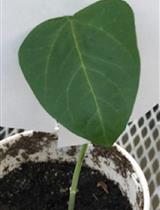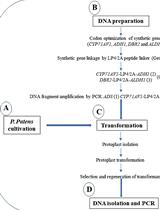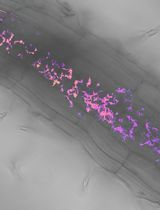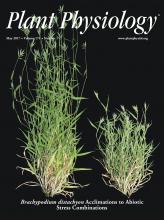- Submit a Protocol
- Receive Our Alerts
- Log in
- /
- Sign up
- My Bio Page
- Edit My Profile
- Change Password
- Log Out
- EN
- EN - English
- CN - 中文
- Protocols
- Articles and Issues
- For Authors
- About
- Become a Reviewer
- EN - English
- CN - 中文
- Home
- Protocols
- Articles and Issues
- For Authors
- About
- Become a Reviewer
Radioactive Tracer Feeding Experiments and Product Analysis to Determine the Biosynthetic Capability of Comfrey (Symphytum officinale) Leaves for Pyrrolizidine Alkaloids
Published: Vol 8, Iss 3, Feb 5, 2018 DOI: 10.21769/BioProtoc.2719 Views: 7237
Reviewed by: Venkatasalam ShanmugabalajiAnonymous reviewer(s)

Protocol Collections
Comprehensive collections of detailed, peer-reviewed protocols focusing on specific topics
Related protocols

Quantification of Methylglyoxal Levels in Cowpea Leaves in Response to Cowpea Aphid Infestation
Jacob R. MacWilliams [...] Isgouhi Kaloshian
Oct 20, 2020 3451 Views

Heterologous Production of Artemisinin in Physcomitrium patens by Direct in vivo Assembly of Multiple DNA Fragments
Nur Kusaira Khairul Ikram [...] Henrik Toft Simonsen
Jul 20, 2023 2283 Views

Utilizing FRET-based Biosensors to Measure Cellular Phosphate Levels in Mycorrhizal Roots of Brachypodium distachyon
Shiqi Zhang [...] Maria J. Harrison
Jan 20, 2025 2289 Views
Abstract
This protocol delivers a method to determine the biosynthetic capability of comfrey leaves for pyrrolizidine alkaloids independently from other organs like roots or flowers.
The protocol applies and combines radioactive tracer experiments with standard and modern techniques like thin layer chromatography (TLC), solid-phase extraction (SPE), high-performance liquid chromatography (HPLC) and gas chromatography-mass spectrometry (GC-MS).
Background
Comfrey roots are known to be able to synthesize pyrrolizidine alkaloids (Frölich et al., 2007) and the key enzyme for biosynthesis, homospermidine synthase (HSS), was localized in the endodermis cells. In addition to this site of synthesis, there have been hints that also leaves of a certain developmental stage might be able to produce pyrrolizidine alkaloids (Niemüller et al., 2012). Therefore, a protocol was developed to determine the biosynthetic capability of comfrey leaves to synthesize pyrrolizidine alkaloids independently from other plant organs.
Materials and Reagents
- epT.I.P.S® pipette tips (Eppendorf, catalog number: 0030000730 )
- Strata SCX 500 mg/6 ml tubes (Phenomenex, catalog number: 8B-S010-HCH )
- Scintillation vial 4 ml (Carl Roth, catalog number: HEE8.1 )
- 1.5 ml microcentrifuge tube (SARSTEDT, catalog number: 72.706.700 )
- 2 ml microcentrifuge tube (SARSTEDT, catalog number: 72.695.500 )
- Scalpel (Carl Roth, catalog number: AH88.1 )
- Microcapillary pipette, volume 1-5 µl (Sigma-Aldrich, catalog number: Z611239 )
- Silica gel G-25 TLC plates 20 x 20 cm (Merck, catalog number: 1003900001 )
- Verex Vial Kit 9 mm, µVial i3 (Phenomenex, catalog number: AR0-9974-12 )
- Hamilton syringe 25 µl (Hamilton, catalog number: 80400 )
- Fresh comfrey leaves from a flowering plant (size about 3.5 cm in length)
- Liquid nitrogen
- [1,4-14C]Putrescine (3.95 GBq/mmol, Amersham Int., catalog number: CFA.301, since the end of Amersham Int., [1,4-14C]Putrescine is still available at PerkinElmer, catalog number: NEC150000MC )
- [12C]Putrescine (Carl Roth, catalog number: 4141.2 )
- Scintillation cocktail, Rotiszint eco plus (Carl Roth, catalog number: 0016.3 )
- Acetonitrile (Carl Roth, catalog number: 7330.1 )
- Methanol (Carl Roth, catalog number: P717.1 )
- Ammonia solution 30% (Carl Roth, catalog number: CP17.1 )
- Sulphuric acid solution volumetric, 0.05 M (VWR, catalog number: 319589-500ML )
- Zinc dust (Carl Roth, catalog number: 9524.2 )
- Sodium hydroxide (NaOH) (Carl Roth, catalog number: 6771.1 )
- Potassium phosphate dibasic (K2HPO4) (Carl Roth, catalog number: T875.1 )
- Potassium phosphate monobasic (KH2PO4) (Carl Roth, catalog number: P018.1 )
- [14C]Retronecine
Note: It was prepared according to Lindigkeit et al., 1997 and Hartmann et al., 2001. - Ethyl acetate (Carl Roth, catalog number: 6784.1 )
- 2-Propanol (Carl Roth, catalog number: 9866.2 )
- 5% ammonia in methanol (see Recipes)
- 100 mM phosphate buffer, pH 7.5 (see Recipes)
- Mobile phase TLC (see Recipes)
Equipment
- Pipettes (Eppendorf, model: Research® plus, catalog number: 3123000063 )
- Microscale
- Fume hood (Thermo Fisher Scientific, catalog number: 1363 )
- Vacuum manifold for SPE (Agilent Technologies, catalog number: 5982-9110 )
- Lamp (Carl Roth, catalog number: 2986.1 )
- Mortar and pestle (Carl Roth, catalog number: NT80.1 )
- Vortex shaker (IKA, model: Vortex 2 )
- Micro stir bars (Carl Roth, catalog number: 0955.1 )
- Magnetic stirrer (IKA, model: lab disc [white] )
- Optima 1 MS GC column (MACHEREY-NAGEL, catalog number: 726205.15 )
- Minispin Microcentrifuge (Eppendorf, catalog number: 5452000018 )
- Radioactivity thin-layer-chromatography detector (RITA, Raytest, Straubenhardt)
- Tri-Carb 2910 TR LSC Low Activity Liquid Scintillation Analyzer (PerkinElmer)
- LiChrograph HPLC (Merck-Hitachi) connected to a fraction collector Pharmacia Frac-100 (GE Healthcare Life Science)
- EC 250/4 NUCLEOSIL® 120-5 C18 HPLC column (MACHEREY-NAGEL, catalog number: 720041.40 )
- Developing chambers for TLC (Carl Roth, catalog number: 3133.1 )
- Shimadzu GC-2010 gas chromatograph with SSL injector (Shimadzu, model: GC-2010 )
- Shimadzu AOC-20i Auto-injector (Shimadzu, model: AOC-20i )
- Fisons MD 800 quadrupole mass spectrometer
Software
- XCalibur 1.1 (Thermo Fisher Scientific, Dreieich, Germany)
- GinaStar TLC (Raytest, Straubenhardt)
- QuantaSmartTM 4.0 (PerkinElmer)
Procedure
- Radioactive tracer feeding experiments
- 169 kBq of [1,4-14C]putrescine solution is transferred into a 2 ml microcentrifuge tube and evaporated to dryness.
Note: Make sure to follow the official guidelines for the work with radioactivity. - 0.04 µmol of [12C]putrescine is weighed on a microscale and transferred into another 2 ml microcentrifuge tube.
Note: The purpose of using also a [12C]putrescine parallel to tracer is to give you the ability of using an equally-treated sample to analyze with hyphenated techniques, like mass spectroscopy, in later stages of this experiment. - 1 ml of tap water is added to each of the tubes of Step A1 and Step A2. Take 5 µl of the [14C]putrescine solution that is mixed with 3 ml of scintillation cocktail and the radioactivity is quantified using the Tri-Carb LSC (Tri-Carb Count Conditions for 14C nuclides are: ‘Nuclide: 14C, Quench Setting Low Energy: 14C; Count Time (min): 5; Count Mode: Normal; Assay Count Cycles: 1; Repeat Sample Count: 1; #Vials/Sample: 1; Calculate % Reference: Off’).
Notes:- For safety reasons, make sure to mark the tubes according to the kind of putrescine that is in solution ([12C] or [14C]) to avoid mix-up of tubes. This labeling should be continued at every consecutive step.
- Any commercially available liquid scintillation counter machine can be used; the mentioned program is used every time radioactivity has to be quantified.
- Keep in mind to always run a blank without any radioactive tracer within a quantification of radioactivity to quantify the background.
- For safety reasons, make sure to mark the tubes according to the kind of putrescine that is in solution ([12C] or [14C]) to avoid mix-up of tubes. This labeling should be continued at every consecutive step.
- Two young comfrey leaves subtending an inflorescence with unopened flower buds are cut from a comfrey plant. Immediately place one leaf in the microcentrifuge tube containing the [14C]putrescine solution, the other in the tube containing the [12C]putrescine solution (Figure 1).

Figure 1. Work flow of tracer feeding and extraction. A. Steps A1 to A3, showing the preparation of the tracer in the microcentrifuge tubes. B. Step A4, showing the incubation of the leaves in the [12C]- and [14C]-tracer solution. C. Steps A6 to A8 refilling the tube with tap water to avoid desiccation of the leaf. D and E. Steps A9 to A10 showing pulverization of the leaves and transfer of the powder into 2 ml microcentrifuge tubes. F and G. Steps A11 to A12 showing acidic extraction of the leaves. - The leaves in the tubes are placed under a 12 h/12 h light/dark regime under the lamp with an intensity of ca. 1,000 lux.
- As soon as the water is taken up by the leaves, another 1 ml of tap water is added. Avoid the petiole to dry out.
- After addition of the tap water to the [14C]putrescine-containing tube, an aliquot of 5 µl is mixed with 3 ml of scintillation cocktail and the radioactivity is quantified using the Tri-Carb LSC.
- Steps A6 and A7 are repeated for four days. After the final addition of 1 ml of tap water to the tube, the amount of radioactivity taken up by the leaf in the [14C]putrescine solution is calculated using this formula: uptake in percent = (169 kBq - [kilobecquerel present in last measurement x 200 + amount of radioactivity measured in the 5 µl steps])/169 kBq x 100.
- Both leaves are frozen separately in liquid nitrogen and pulverized with mortar and pestle.
Note: The mortar and the pestle will retain plant debris in their pores. Especially the mortar and pestle used with the leaf sample incubated with [14C]putrescine has to be treated carefully after use to decontaminate residual radioactivity. - Each of the pulverized leaves is transferred into a 2 ml microcentrifuge tube (labeled [14C]-leaf and [12C]-leaf, respectively).
- 1.5 ml of 0.05 M H2SO4 is added to each of the two samples in the centrifuge tubes.
- The closed tubes of Step A11 are vortexed for 3 min at room temperature and the cell debris is separated by centrifugation (10 min, 5,000 x g).
- The supernatants of Step A12 are transferred, each, into a fresh 2 ml microcentrifuge tube containing a micro stir bar.
- An aliquot of 5 µl is taken from each tube of Step A13, mixed with 3 ml of scintillation cocktail and the radioactivity of the sulphuric extract is quantified via Tri-Carb LSC.
- In each tube of Step A13 a spatula tip of zinc dust is added and stirred for three hours on a magnetic stirrer.
Note: Zinc dust reduces the alkaloid N-oxides present in your sample to the tertiary alkaloid and may result in formation of foam rising in your tube. Avoid spilling of your sample. - Each tube of Step A15 is centrifuged (10 min, 5,000 x g) and the clear supernatant is applied to a Strata SCX-SPE cartridge positioned on the vacuum manifold. The cartridges were conditioned with 6 ml of methanol and equilibrated with 6 ml of 0.05 M H2SO4 prior to use.
Notes:- Since there is most likely residual radioactivity in the Zinc make sure to dispose the Zinc as solid radioactive material.
- After each treatment, the Strata SCX-SPE cartridge is dried by applying vacuum for an additional minute to the cartridge.
- Since there is most likely residual radioactivity in the Zinc make sure to dispose the Zinc as solid radioactive material.
- An aliquot of 5 µl of the flow-through of each of the Strata-SCX cartridges is mixed with 3 ml of scintillation cocktail to quantify the radioactivity that is incorporated into non-alkaloid metabolites using the Tri-Carb LSC (Figure 2).

Figure 2. Solid phase extraction setup. Steps A17 to A21 are shown. On the left: SPE cartridges assembled onto the vacuum manifold loaded with sample. On the right: test tubes of the vacuum manifold with their label and the scintillation vials. - The loaded Strata SCX-SPE cartridges of Step A16 are washed on the vacuum manifold first with 12 ml of deionized water and then with 12 ml of methanol.
- An aliquot of 5 µl of the flow-through from the washing steps of each of the Strata-SCX cartridges is mixed with 3 ml of scintillation cocktail to quantify the radioactivity using the Tri-Carb LSC.
- The washed cartridges of Step A18 are eluted using the vacuum manifold with a glass tube positioned under each of the two cartridges by applying three times 6 ml of methanol containing 5% (v/v) of ammonia (Recipe 1). The three elution fractions of each cartridge are combined.
- An aliquot of 5 µl of the combined elution fractions is mixed with 3 ml of scintillation cocktail to quantify radioactivity that was incorporated into the alkaloid compounds using the Tri-Carb LSC.
Note: The cartridge will most likely retain some radioactive molecules (very strong bases), make sure to dispose properly. - The solvent of the combined elution fractions in both tubes of Step A20 is evaporated.
- The dry residue of the [14C]-labeled sample (Step A22) is dissolved in 2 ml of methanol and divided into equal parts by transfer 1 ml in each of two 2 ml microcentrifuge tubes. The tubes are labeled (#23a) and (#23b).
- The methanol of both samples (tubes #23a and #23b) is evaporated.
- The dry residue of sample #23a is dissolved in 50 µl of methanol and stored at -20 °C (to be used in Step A31).
- The dry residue of sample #23b is dissolved in 2 ml of 2 N NaOH. The tube is closed and heated in a heating block at 60 °C for 3 h. Afterwards the tube is opened and the solvent evaporated over 2 days under a fume hood (see Notes 1 and 2).
- The dry residue of the [12C]-labeled sample of (Step A 22) is dissolved in 2 ml of 2 N NaOH. The tube is closed and incubated in a heating block at 60 °C for 3 h. Afterwards, the tube is opened and the solvent evaporated over 2 days under a fume hood (see Notes 1 and 2).
- The dry residue of hydrolyzed samples of Step A26, labeled with [14C], and Step A27, labeled with [12C], are dissolved in 50 µl of methanol, each, and stored at -20 °C (to be used in Steps A34 and B1).

Figure 3. Example of the tracer surveillance. Data according to Kruse et al. (2017). - The HPLC column is equilibrated with 85% solvent A (100 mM phosphate buffer, pH 7.5, Recipe 2) and 15% solvent B (acetonitrile) at 1 ml/min for 1.5 h.
- The fraction collector Frac-100 is equipped with 4 ml scintillation vials.
- 20 µl of the sample from Step A25 is transferred with a Hamilton syringe into the rheodyne injector-loop of the LiChrograph HPLC and the valve is changed to the inject position. The fraction collector is programmed to a fraction size of 500 µl.
- After the HPLC run finished (25 min), 3 ml of scintillation cocktail is added to each fraction collected in the scintillation vials. The vials are closed and radioactivity is quantified with the Tri-Carb LSC (Figure 4).
- The HPLC column is reequilibrated after the run for 1.5 h as described in Step A29.
- Steps A30 to A33 are repeated with the [14C]-labeled sample from Step A28.
- Steps A30 to A33 are repeated with the [14C]retronecine standard.
- An aliquot of 10 µl of the remaining [14C]-labeled sample from Step A28 is mixed in a 1.5 ml microcentrifuge tube with 10 µl of the [14C]retronecine standard.
- Steps A30 to A33 are repeated with the sample of Step A36.

Figure 4. Example of a plotted radio- chromatograms. A. The unhydrolyzed purified extract of Step A32. B. The hydrolyzed purified extract of Step A34. C. The [14C]retronecine standard of Step A35. D. Mixture of standard and hydrolyzed extract of Step A37. Data according to Kruse et al. (2017).
- 169 kBq of [1,4-14C]putrescine solution is transferred into a 2 ml microcentrifuge tube and evaporated to dryness.
- Product analysis
- The 20 µl remaining of the [14C]-labeled sample from Step A28 is applied as aliquots of 5 µl onto a TLC plate by using the microcapillary pipette. Make sure that the solvent is completely evaporated before applying the next aliquot. This lane is labeled [14C].
- The complete [12C]-labeled sample from Step A28 is applied to the lane parallel to that of Step B1 in the same manner as described in Step B1. The lane is labeled [12C].
- The TLC is developed in a presaturated TLC developing chamber with 20 ml of mobile phase (ethyl acetate:isopropyl alcohol:ammonium hydroxide [30%, v/v]: 45:35:20, Recipe 3).
- The TLC plate is dried under a fume hood overnight.
- The radioactivity of the TLC plate is detected using the RITA system with GinaStar TLC software. The area of the [12C]-lane that is parallel to the radioactive spot of the [14C]-lane is scrapped off including the area 1 cm above and 1 cm below with a spatula into a 2 ml microcentrifuge tube (Figure 5).

Figure 5. Workflow for product analysis. A. Steps B1 to B4 41 showing the developed TLC. B. Step B5 showing the spots labeled after detection of radioactivity with the RITA system. C. Step B5 showing the spot on the [12C]-TLC lane that is parallel to the radioactivity spot and is scraped off. D. Steps B5 to B6 show the silica gel powder scraped off the TLC plate and transferred to a 2 ml microcentrifuge tube. - The silica gel powder of Step B5 is suspended by adding 1 ml of the mobile phase to the microcentrifuge tube. The sample is shaken vigorously and centrifuged (1 min, 5,000 x g). The supernatant is transferred into a fresh 2 ml microcentrifuge tube and evaporated under a fume hood.
- Step B6 is repeated three times with transfer of the supernatant into the same 2 ml microcentrifuge tube to ensure full extraction.
- The dry residue resulting from Step B7 is dissolved in 25 µl of methanol and transferred into a µVial for GC-MS analysis. 1 µl is injected with the AOC-20i auto-injector and electron-impact mass spectra are recorded at 70 eV. Gas chromatography conditions are as follows: injector: 250 °C; injection mode splitless; splitless time 1 min, temperature program: 60 °C for 3 min and 60 °C to 300 °C at 16 °C min-1; carrier gas, helium at 1 ml min-1 (Figure 6).
Note: Any commercially available GC-MS system can be used for this purpose, a direct injection of the radioactive area is not recommended, by reason of the risk for contaminating expensive equipment and of the non-availability of 14C-labeled reference spectra.
Figure 6. Example of a GC-MS run. A. Showing the total ion chromatogram (TIC) of the sample measured at Step B8. B. Showing the extracted ion chromatogram for the molecular weight of hydrolyzed pyrrolizidine alkaloids from comfrey. C. Showing the mass spectrum at the retention index 1,478, the largest peak of the TIC and EIC, identified as retronecine by comparison with literature and NIST database. Data according to Kruse et al. (2017).
- The 20 µl remaining of the [14C]-labeled sample from Step A28 is applied as aliquots of 5 µl onto a TLC plate by using the microcapillary pipette. Make sure that the solvent is completely evaporated before applying the next aliquot. This lane is labeled [14C].
Data analysis
- The data resulting from measurement of radioactivity of the sample aliquots with the Tri-Carb LSC in Steps A1 to A8 allow calculation of the total uptake of [14C]putrescine as a tracer by the comfrey leaves given in decays per minute (dpm).
The radioactivity is calculated using the following formula:
Total Radioactivity [dpm] = (measured radioactivity) [dpm] x (total volume) [µl]/5
The values for radioactivity resulting from aliquots taken in Steps A14 to A21 allow conclusions about the chemical properties of the metabolites that incorporated radioactivity: The amount of radioactivity in the sulfuric extract indicates the amount of radioactivity incorporated into water soluble and acidic extractable molecules. As they eluted from the SPE with ammoniacal methanol they are most likely weak bases as, for example, alkaloids (Figure 3). - The HPLC runs of Steps A30 to B1 do not require an HPLC detector since the radioactivity measured for the individual fractions is plotted against the fraction time point and thereby delivering a direct radio-chromatogram. This can be done by using standard data-processing software like Microsoft Excel, Apple Numbers or Libre Calc or manually on paper. The resulting peaks deliver insights if the SPE-purified molecules that incorporated tracers carry side chains that are esterified to the [14C]-labeled core structure originating from the tracer. A comparison with standards is already the first evidence for a possible incorporation of putrescine into alkaloids.
- The GC-MS total ion chromatogram of the compounds extracted from the TLC spot will further be processed, in the case of pyrrolizidine alkaloids, by extracting the ion 155 m/z representing the [M]+ molecule of the retronecine core structure. In the case of a single peak, the EI mass spectrum of this peak allow comparisons with spectral libraries like NIST or data previously published of pyrrolizidine alkaloids.
Notes
- Make sure to close the tubes properly. For safety reasons, it is recommended to put some weight on the cap of the tubes to avoid them being opening by the heat.
- This process can take very long depending on the laminar air flow of the fume hood and can be speeded up by mixing the water with methanol in a 1:1 ratio, or by using a nitrogen flow or a centrifugal evaporator.
Recipes
- 5% ammonia in methanol
In a volumetric flask, 16.67 ml of 30% ammonia solution is added to 83.33 ml of methanol - 100 mM phosphate buffer, pH 7.5
2.449 g KH2PO4 and 14.143 g K2HPO4 are weighed into a volumetric flask and made up to 1 L with deionized water - Mobile phase TLC
In a beaker, 45 ml of ethyl acetate is mixed with 35 ml of 2-propanol and 20 ml of 30% (v/v) ammonia solution. The mobile phase has to be prepared fresh prior to use
Acknowledgments
This work was funded by a DFG grant given to Dietrich Ober. We thank Dr. Dorothee Langel for her input and ideas contributing to this method. We thank Dr. Christoph Gelhaus and Maren Hartelt, Kiel University, for help in implementing this method. The authors declare no conflict of interest.
References
- Frölich, C., Ober, D. and Hartmann, T. (2007). Tissue distribution, core biosynthesis and diversification of pyrrolizidine alkaloids of the lycopsamine type in three Boraginaceae species. Phytochemistry 68(7): 1026-1037.
- Hartmann, T., Theuring, C., Witte, L. and Pasteels, J. M. (2001). Sequestration, metabolism and partial synthesis of tertiary pyrrolizidine alkaloids by the neotropical leaf-beetle Platyphora boucardi. Insect Biochem Mol Biol 31(11): 1041-1056.
- Kruse, L. H., Stegemann, T., Sievert, C. and Ober, D. (2017). Identification of a second site of pyrrolizidine alkaloid biosynthesis in comfrey to boost plant defense in floral stage. Plant Physiol 174(1): 47-55.
- Lindigkeit, R., Biller, A., Buch, M., Schiebel, H. M., Boppre, M. and Hartmann, T. (1997). The two faces of pyrrolizidine alkaloids: the role of the tertiary amine and its N-oxide in chemical defense of insects with acquired plant alkaloids. Eur J Biochem 245(3): 626-636.
- Niemüller, D., Reimann, A. and Ober, D. (2012). Distinct cell-specific expression of homospermidine synthase involved in pyrrolizidine alkaloid biosynthesis in three species of the boraginales. Plant Physiol 159(3): 920-929.
Article Information
Copyright
© 2018 The Authors; exclusive licensee Bio-protocol LLC.
How to cite
Readers should cite both the Bio-protocol article and the original research article where this protocol was used:
- Stegemann, T., Kruse, L. H. and Ober, D. (2018). Radioactive Tracer Feeding Experiments and Product Analysis to Determine the Biosynthetic Capability of Comfrey (Symphytum officinale) Leaves for Pyrrolizidine Alkaloids. Bio-protocol 8(3): e2719. DOI: 10.21769/BioProtoc.2719.
- Kruse, L. H., Stegemann, T., Sievert, C. and Ober, D. (2017). Identification of a second site of pyrrolizidine alkaloid biosynthesis in comfrey to boost plant defense in floral stage. Plant Physiol 174(1): 47-55.
Category
Plant Science > Plant metabolism > Other compound
Biochemistry > Other compound > Alkaloid
Do you have any questions about this protocol?
Post your question to gather feedback from the community. We will also invite the authors of this article to respond.
Share
Bluesky
X
Copy link









